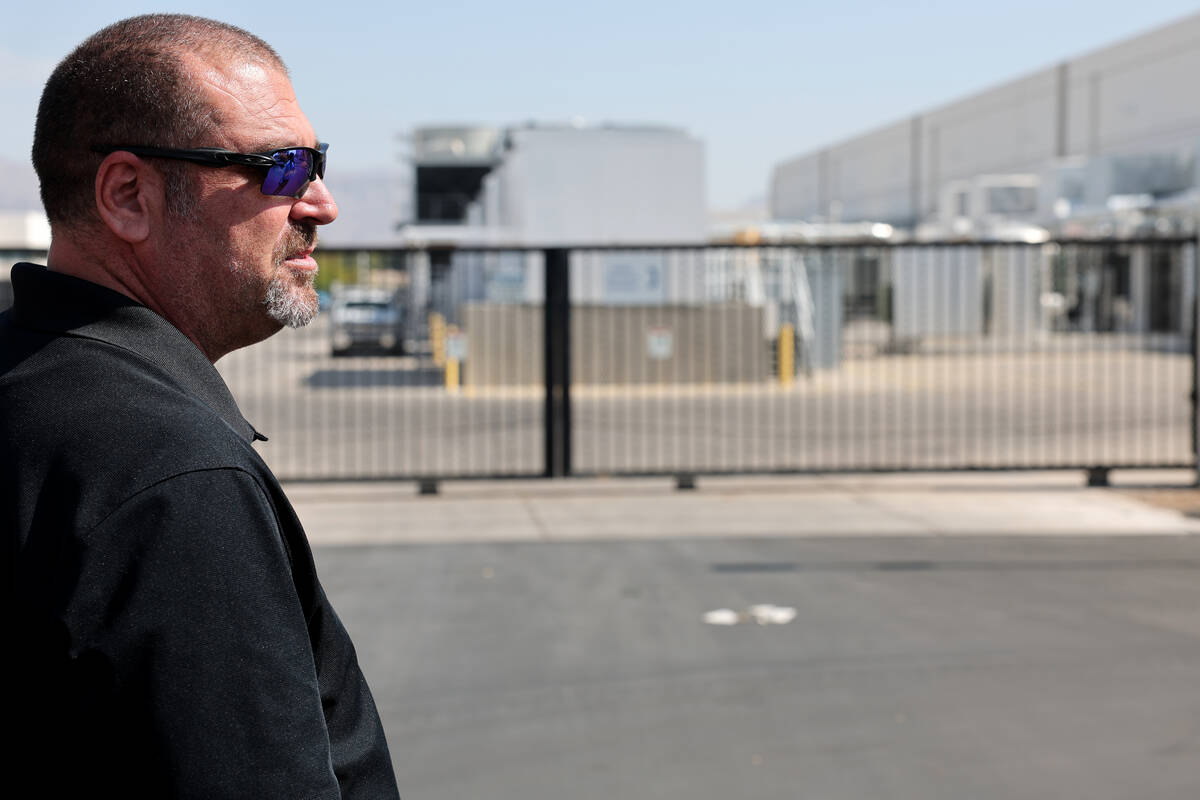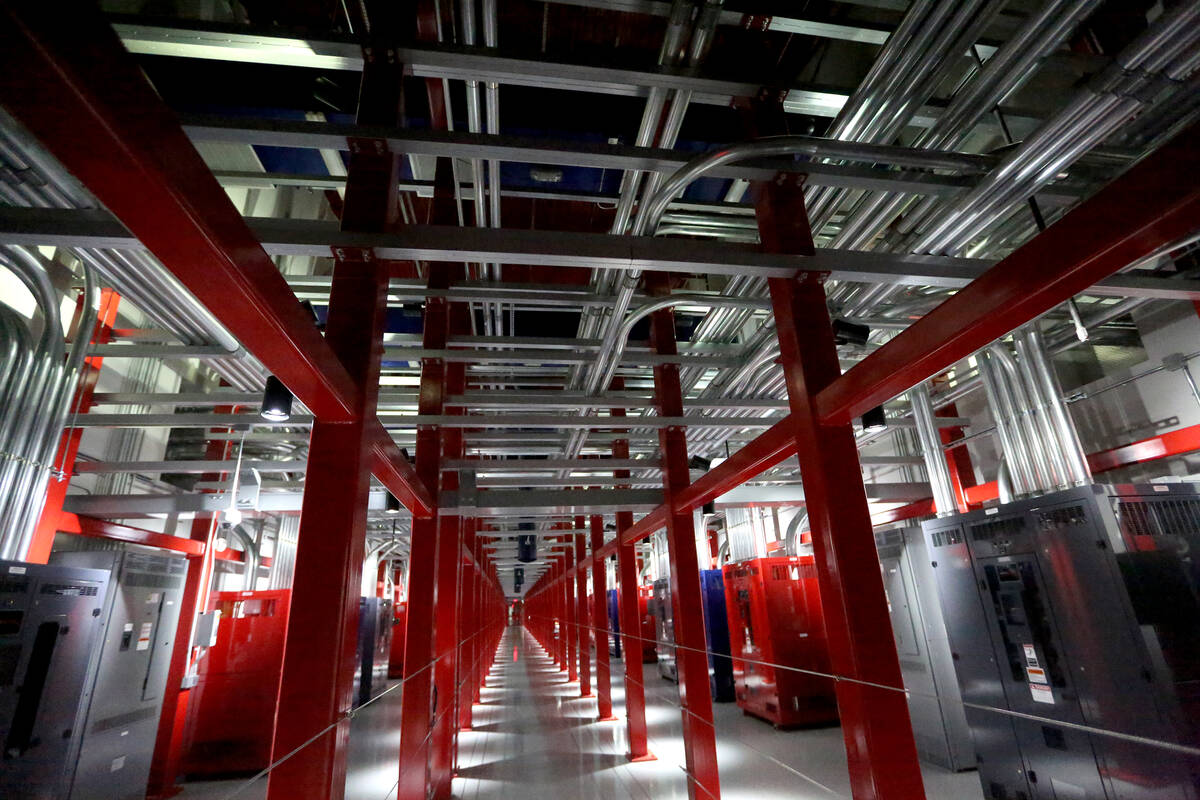Southern Nevada data centers used a ton of water in 2024. Here’s how
The centerpiece of Flexential’s North Las Vegas data center is a massive room holding server boxes with blue and yellow wires twisting above.
Walking between servers sectioned off behind cages and ceiling-high panels, the facility feels oddly chilly. Servers typically generate large amounts of heat, but through different technologies, data centers quickly route it outside. Some of these methods involve evaporating a lot of water.
Flexential’s North Las Vegas facility is one of more than 30 data centers spread across the Las Vegas Valley. Other facilities belong to companies such as Switch and Google, which has a site in Henderson. Data centers provide infrastructure necessary to support websites, data storage and even online gaming.
In Nevada, the country’s driest state, the recent growth of generative artificial intelligence has put increased attention on data centers’ power demands and the water needed to cool servers. This comes as Lake Mead risks hitting crisis levels, and more groundwater has been signed away in parts of Northern Nevada than is actually available.
Water usage is a key concern among environmental activists when it comes to AI and data centers, said Kyle Roerink, executive director of the Great Basin Water Network. The nonprofit protects “the water resources of the Great Basin for residents, animals and plants,” according to its website.
“I can sit here and complain to you about AI all day and how much water it’s going to consume and how much power it’s going to consume, but investors know that these tech companies are preying on our very human instincts,” Roerink said.
Particularly during its training phase, AI can require vast amounts of water, said Renkun Chen, professor at the University of California San Diego.
“AI, at least today’s AI, for data centers, is very energy intensive,” Chen explained. “That’s why, today’s data centers, when they are built, they need to one: consume a lot of power, and second: They need to oftentimes consume a lot of water.”
Out of a list of 23 data centers provided by the Las Vegas Valley Water District, the city of North Las Vegas and the city of Henderson, Google’s site had the highest estimated water use in 2024 at roughly 352 million gallons. The Flexential facility used around 20 million gallons.
The sum of every facility’s estimated usage in 2024 was more than 716 million gallons. That’s enough to sustain about 4,395 single-family households for a year.
“The vast majority — if not all” of the provided data centers serviced by the Las Vegas Valley Water District draw water from the Colorado River, spokesperson Bronson Mack said. Southern Nevada gets almost 90 percent of its water from the Colorado River through Lake Mead, and the reservoir was only 31 percent full in June amidst worries it could return to crisis levels.
Water as a coolant
Data centers use water for various methods of cooling. It’s sometimes part of mixtures that circulate in pipes absorbing heat from computing hardware.
The Flexential data center uses a compound called “glycol” instead of water for cooling loops, area manager Todd Gaither said.
“What that does is it takes that heat outside, blows it off, and then the liquid that comes back is the coolant that keeps it going,” he explained.
Not every server at the facility uses that method though. Gaither said many servers are “air cooled,” meaning heat dissipates through the air, flows through vents and is absorbed by water containers. Water vapor releases into the environment outside as a byproduct.
“It’s evaporating the water to get the heat (to) blow off,” Gaither said. “Very efficient, but it’s not friendly to, well, arguably, there’s an argument everywhere, you know?”
Roerink said due to stricter regulations, sites operating in the Las Vegas Valley actually tend to be more efficient with water consumption than facilities in other parts of the state. That’s with the caveat that many data centers use power generated from fracked natural gas.
“The Southern Nevada Water Authority has set a good example, because they have made it very clear, if your business model is highly water consumptive, don’t come around,” Roerink added.
The Las Vegas Valley is one of Flexential’s “top priority markets,” and executives hope to eventually build an upgraded facility in the area, President and COO Ryan Mallory said. The company emphasizes sustainability in Southern Nevada because of bonds requiring a certain level of environmental efficiency and due to oversight from regulators, he added.
“There’s nothing you can do on this scale that won’t get you put under a microscope,” Mallory said.
Data centers up north
The most significant collection of Nevada data centers isn’t in the Las Vegas Valley. It’s about nine miles east of Reno and Sparks, at the Tahoe-Reno Industrial Center.
The industrial park is home to some of the largest names in the tech industry. These include Tesla, which built a 5.4 million-square-foot “gigafactory,” and companies such as Switch and Google that own large data centers in the industrial center.
Mallory said some of the country’s biggest data centers, possibly those in Northern Nevada, evaporate large amounts of water for cooling.
“They’re using water to create that heat exchange,” he said. “That leads to a tremendous amount of evaporation.”
When it comes to Northern Nevada and the Reno area, Roerink said there’s significantly less actual groundwater available than what’s been allocated to homes, businesses and other entities in the area. This is known as “paper water.”
The Southern Nevada Water Authority has incentives for returning water to Lake Mead that don’t exist for Reno’s water utility: the Truckee Meadows Water Authority (TMWA). Environmental conditions in the two areas are also much different.
“When you compare the conservation ethic of the (Southern Nevada Water Authority) to the Truckee Meadows Water Authority, there’s really no comparison at this point,” Roerink said.
Danny Rotter, assistant general manager of the TMWA, said he doesn’t believe water along the Truckee River has been appropriated to an unhealthy level, especially when compared to the Colorado River. Groundwater is a different story, he said.
“There are more paper rights than wet water, however TMWA is constantly looking at that to make sure we are managing our drawing sustainably,” Rotter added.
In 2019, former Nevada State Engineer Tim Wilson denied further appropriations of groundwater in the Tracy Segment Hydrographic Basin, which partially supplies the Tahoe-Reno Industrial Center, as there was “no unappropriated water available at the proposed source,” according to state documents.
Cooling the industrial park
The TMWA’s service area doesn’t include the Tahoe-Reno Industrial Center, just areas to the west, namely Reno, Sparks and portions of Washoe County. Water utilities in the industrial park are managed by the TRI General Improvement District. The Storey County Board of Commissioners created the special district in 2000 to serve the area.
Shari Whalen, general manager at the TRI General Improvement District, said even if data centers use less water-intensive technologies, they might still consume significant amounts of water indirectly.
“Some of our customers feel they’re reducing their carbon footprint by using dry cooling and not using water, but they’re getting that power from power plants that have evaporative cooling,” she said.
There’s a “real misunderstanding” about the amount of water data centers actually use, Whalen added. Certain facilities utilize methods that consume significantly less water.
“They employ different cooling technologies,” she explained. “And then other companies use evaporative cooling, and they’re using different water resources. They’re using treated effluent as opposed to potable water.”
Effluent is sewage water. The TRI General Improvement District imports effluent from wastewater providers in the TMWA’s service area, and some is used for cooling in data centers.
Back in North Las Vegas, the Flexential facility remains active 24/7, hosting servers running AI and other programs. Gaither said he likes to joke that every minute of downtime is “a billion dollars” lost.
“I think that the industry is very responsible and very regulated, and I think that people don’t see that. Cause it’s not a visible industry,” Gaither said. “We constantly are raising the bar, adopting new technologies to be more effective and more efficient.”
Contact Finnegan Belleau at fbelleau@reviewjournal.com.






















